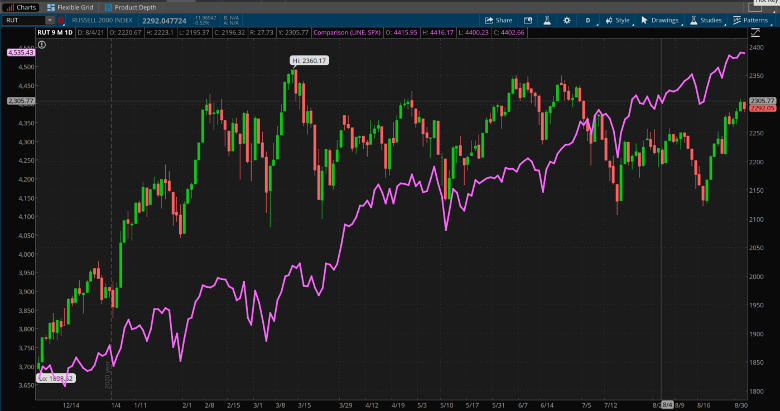Back To Work, And Maybe Back To Normal Trading Volume?
Looking Back At Jobs Data: It’s Not All Bad

CHART OF THE DAY: GOLIATH BEATING DAVID. The small-cap Russell 2000 Index (RUT—candlestick) started out the year way ahead of the large-cap S&P 500 Index (SPX—purple line). Since March, however, it’s been the SPX leading the way. A major contributor to the gain in the SPX was its largest members, the so-called “mega-cap” Tech companies with market caps of $1 trillion or more. Data sources: FTSE Russell, S&P Dow Jones Indices. Chart source: The thinkorswim® platform. For illustrative purposes only. Past performance does not guarantee future results.
Price Pain: Although small-caps enjoyed a decent run over the last couple of weeks, the Russell 2000 Index remains about 3% below its all-time peak reached back in March. The S&P 500 Index is up 16% since RUT made its high. This is kind of opposite of what you might expect in a post-recession economy. Small-caps frequently lead the charge out of the gate after the tide turns. You’d think that all the economic stimulus this year—much of which people likely spent on things like travel and dining out—would have helped small-caps in industries like restaurants and hotels. Also, the booming housing market could have boosted the fortunes of many smaller bank stocks, which happen to be well represented in the RUT.
For a while, it looked like that was happening. The RUT climbed an amazing 19% between the end of 2020 and mid-March. Since then it’s treaded water. One possible reason? Inflation. As one analyst told our media affiliate, the TD Ameritrade Network* last week, small-caps can be more susceptible than larger ones to the impact of inflation because small-caps often have inferior pricing power compared with large caps. A small company that’s forced to pay up for employees and goods during inflationary times can try to pass along costs to customers or take a hit to the margins. Customer resistance to higher prices from smaller companies means the choice often ends up being a margin hit, which can hurt profitability. Obviously, large-caps face the same challenges, but tend to have more pricing power. Companies like Coca-Cola (NYSE:KO), Kimberly-Clark (NYSE:KMB) and Procter & Gamble (NYSE:PG) announced price rises earlier this year. Those companies share one thing in common: They’re huge.
Chipping Off Old Engine Block Supply: It’s been four decades since cars ran on standard engines and parts. Unless you’re going real old school vintage, or hoping to snatch a refurbished “hooptie,” your car needs semiconductor chips. As you know by now, the global chip bowl has been running low, and “re-ups” are getting further and further in the offing. No re-up means no new ride (or very few, at least).
So, it shouldn’t be much of a surprise to learn that General Motors (NYSE:GM) last week announced it's shutting down or significantly reducing production across plants in North America, Canada and Mexico. This coincides with a similar move by Ford (NYSE:F), which also announced last week that it’s halting production of pickups and other profitable models in its Missouri, Michigan and Kentucky plants. In case you’re wondering, the chip shortage is affecting automakers across the globe, like Toyota (NYSE:TM), Nissan (OTC:NSANY) and even British manufacturer Vauxhall Motors, which was recently acquired by Dutch conglomerate Stellantis (NYSE:STLA). As the vehicle market remains tight, car prices have surged to record levels. And while car sales dropped in July, the electronic components sector—the businesses that snapped up most of the chips—is experiencing a sales boom, according to a recent BBC report. Year to date, all of the above carmakers are trailing the SPX in market performance, save Ford, which leads the pack by a wide margin. However, some analysts argue that most of the chip shortage negativity has now been priced into auto stocks. Time will tell.
Our Snacking Habits Might Be Curtailed: But not for the usual reasons pertaining to our waistlines. Mondelez (NASDAQ:MDLZ), the maker of Ritz and Saltine crackers and Oreo cookies, is in its fourth week of a strike by unionized workers at its bakeries and distribution centers in at least five states who oppose proposed contract changes to work schedules, overtime and health care. This is on top of global supply chain issues and labor shortages that have impacted everything from microchips to potato chips. Retailers have been left scrambling to figure out the right balance of supply and demand for their shelves.
So far, the consumer staples industry is up about 8% year to date, that compares with about 20% for the SPX, and about 5.7% for MDLZ, despite decent earnings that have beat analysts’ expectations. Plus the fact that we’ve been closer to the kitchen cabinet where the Oreos are kept while working from home during the pandemic. Something to chew on.
Disclaimer: TD Ameritrade® commentary for educational purposes only. Member SIPC. Options involve risks and are not suitable for all investors. Please read Characteristics and Risks of Standardized Options.
